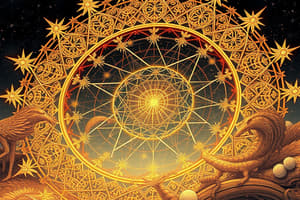Podcast
Questions and Answers
¿Cuál es el propósito principal de la teoría de conjuntos?
¿Cuál es el propósito principal de la teoría de conjuntos?
- Agrupar y organizar objetos o cosas (correct)
- Estudiar la relacion entre números y figuras
- Clasificar objetos en categorías
- Desarrollar diagramas de Venn
¿Qué símbolo se utiliza para representar la unión de conjuntos?
¿Qué símbolo se utiliza para representar la unión de conjuntos?
- ∩
- =
- ∪ (correct)
- -
¿Cuál es el término utilizado para describir un conjunto con un solo elemento?
¿Cuál es el término utilizado para describir un conjunto con un solo elemento?
- Conjunto vacío
- Conjunto finito
- Conjunto singleton (correct)
- Conjunto infinito
¿Qué es el conjunto que no contiene elementos?
¿Qué es el conjunto que no contiene elementos?
¿Qué resultado se obtiene al encontrar la diferencia entre los conjuntos {1, 2, 3} y {3, 4, 5}?
¿Qué resultado se obtiene al encontrar la diferencia entre los conjuntos {1, 2, 3} y {3, 4, 5}?
¿Cuál es el nombre del diagrama que se utiliza para mostrar la unión y la intersección de conjuntos?
¿Cuál es el nombre del diagrama que se utiliza para mostrar la unión y la intersección de conjuntos?
Study Notes
What is Set Theory?
- Set theory is a way to group and organize objects or things.
- It's like putting toys away in a toy box, but instead of toys, we're working with numbers, shapes, or other things.
Basic Concepts
- Set: A collection of unique objects, called elements or members.
- Element: A single object in a set.
- Member: Another word for element.
Set Notation
- We use curly brackets
{ }to show a set. - For example,
{1, 2, 3, 4, 5}is a set of numbers from 1 to 5.
Types of Sets
- Empty Set: A set with no elements, denoted by
{ }or∅. - Singleton Set: A set with only one element, e.g.
{5}. - Finite Set: A set with a limited number of elements, e.g.
{1, 2, 3, 4, 5}. - Infinite Set: A set with an endless number of elements, e.g. all natural numbers.
Set Operations
- Union: Combining two or more sets to get all the elements, denoted by
∪. - Intersection: Finding the elements common to two or more sets, denoted by
∩. - Difference: Finding the elements in one set that are not in another set, denoted by
-.
Examples
- Union:
{1, 2, 3} ∪ {3, 4, 5} = {1, 2, 3, 4, 5} - Intersection:
{1, 2, 3} ∩ {3, 4, 5} = {3} - Difference:
{1, 2, 3} - {3, 4, 5} = {1, 2}
Fun Activities
- Create a set of your favorite toys or books.
- Draw a Venn diagram to show the union and intersection of two sets.
- Play a game where you identify elements in a set or find the difference between two sets.
Studying That Suits You
Use AI to generate personalized quizzes and flashcards to suit your learning preferences.
Description
Aprende los conceptos básicos de la teoría de conjuntos, incluyendo tipos de conjuntos, notación y operaciones. Practica creando conjuntos y resolviendo ejercicios de unión, intersección y diferencia.




